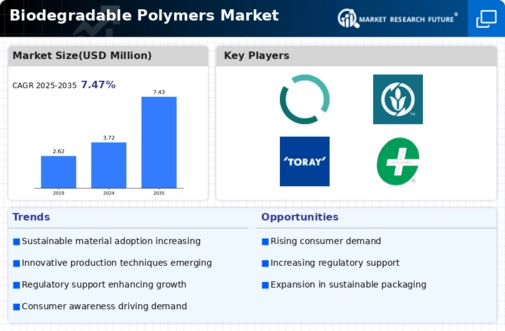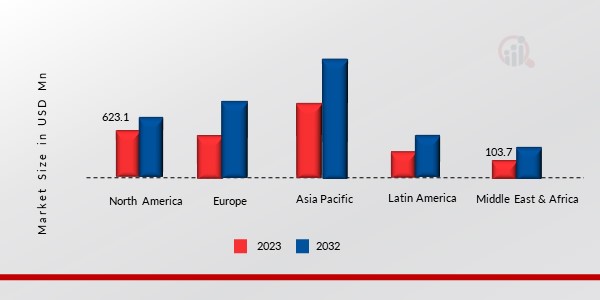Market Share
Biodegradable Polymer Market Share Analysis
Market share positioning strategies are crucial for companies operating in the biodegradable polymers market, a sector at the forefront of sustainable packaging and material innovation. Biodegradable polymers, also known as bioplastics, offer a promising alternative to conventional plastics, mitigating environmental concerns such as plastic pollution and resource depletion. To succeed in this rapidly growing market, companies deploy strategic approaches tailored to market dynamics, consumer preferences, and regulatory requirements.
Product innovation and differentiation emerge as primary strategies for companies aiming to establish a strong presence in the biodegradable polymers market. By developing innovative biodegradable polymer formulations with unique properties, functionalities, or applications, firms seek to capture the attention of environmentally conscious consumers and gain a competitive edge. For example, companies may focus on creating biodegradable polymers optimized for specific packaging requirements, such as films for food packaging, trays for fresh produce, or containers for personal care products. This differentiation not only allows companies to address niche market segments but also helps in building brand loyalty among consumers seeking sustainable packaging solutions.
Cost leadership represents another essential strategy in the biodegradable polymers market, particularly as sustainability becomes increasingly important across industries. Companies adept in this strategy focus on optimizing production processes, minimizing manufacturing costs, and offering competitive pricing for biodegradable polymer products. By providing cost-effective alternatives to conventional plastics, these companies attract price-sensitive customers, such as packaging manufacturers, retailers, and consumer brands, and gain market share through increased adoption and sales volume, thereby solidifying their market position.
Market segmentation plays a crucial role in shaping market share positioning strategies for biodegradable polymer manufacturers. By segmenting the market based on factors such as end-user industries, product types, or geographic regions, companies can tailor their offerings to meet the specific needs and preferences of diverse customer segments. For instance, firms may develop specialized biodegradable polymer solutions targeting different sectors such as food and beverage packaging, agriculture, textiles, or automotive applications, each customized to deliver optimal performance within its intended application domain. This strategic segmentation facilitates targeted market penetration and enables firms to capitalize on emerging opportunities within niche segments, thereby enhancing their overall market share.
Strategic partnerships and collaborations serve as instrumental avenues for market share positioning within the biodegradable polymers market. By forging alliances with raw material suppliers, packaging manufacturers, retailers, or sustainability-focused organizations, companies can leverage complementary resources, expertise, and distribution networks to expand their market reach and penetration. Collaborative initiatives may include joint product development ventures, strategic supply chain partnerships, or cooperative marketing campaigns aimed at enhancing brand visibility and market presence. Through strategic collaborations, firms can access new markets, distribution channels, and customer segments more efficiently, thereby boosting their market share and competitive edge.
Investment in research and development (R&D) emerges as a cornerstone of market share positioning strategies for biodegradable polymer manufacturers. By continually innovating and enhancing their product offerings, companies can stay ahead of market trends, technological advancements, and regulatory requirements. This may involve developing new biodegradable polymer formulations with improved mechanical properties, thermal stability, or compostability, or creating novel applications for biodegradable polymers in areas such as 3D printing, medical devices, or consumer electronics. By investing in R&D initiatives, firms not only strengthen their competitive position but also foster innovation-driven growth and market leadership within the dynamic biodegradable polymers industry.
Branding and marketing efforts play a pivotal role in market share positioning within the biodegradable polymers market. Through strategic branding initiatives and targeted marketing campaigns, companies aim to enhance brand visibility, establish brand identity, and differentiate their offerings from competitors. This may involve highlighting the sustainability, performance, and versatility of their biodegradable polymer products, emphasizing their compliance with regulatory standards and certifications, or showcasing their applications across various industries through various marketing channels such as advertising, trade shows, or digital media. By effectively communicating the unique selling propositions of their products, companies can resonate with customers, foster brand loyalty, and capture a larger share of the market.
Regulatory compliance and product quality assurance are critical imperatives for market share positioning within the biodegradable polymers market. Companies must adhere to stringent regulatory standards governing biodegradability, compostability, and environmental sustainability to ensure consumer safety and environmental protection. By implementing robust quality control measures, conducting regular audits, and obtaining necessary certifications, firms can demonstrate their commitment to excellence and gain a competitive advantage in the market. Moreover, adherence to regulatory mandates fosters consumer trust, enhances brand credibility, and facilitates market share expansion within the biodegradable polymers industry.








Leave a Comment